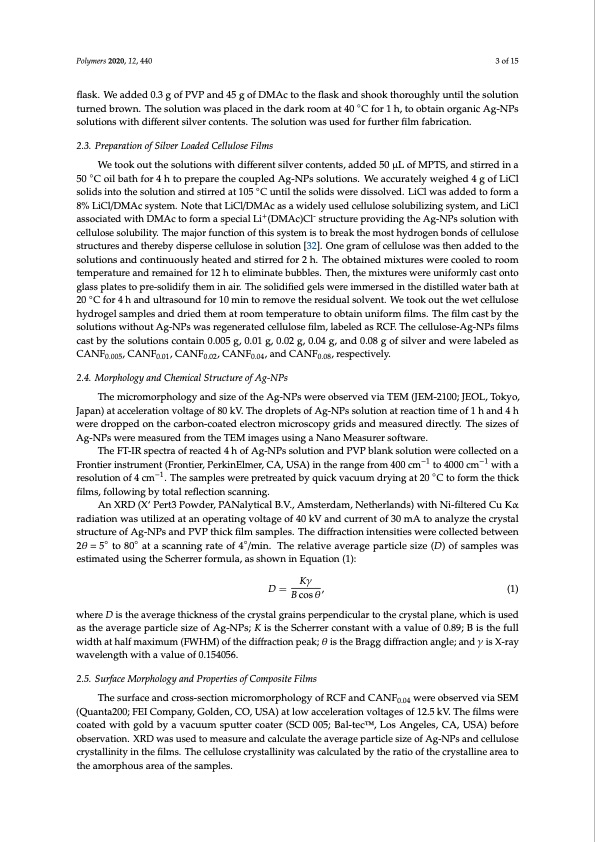
PDF Publication Title:
Text from PDF Page: 003
Polymers 2020, 12, 440 3 of 15 flask. We added 0.3 g of PVP and 45 g of DMAc to the flask and shook thoroughly until the solution turned brown. The solution was placed in the dark room at 40 ◦C for 1 h, to obtain organic Ag-NPs solutions with different silver contents. The solution was used for further film fabrication. 2.3. Preparation of Silver Loaded Cellulose Films We took out the solutions with different silver contents, added 50 μL of MPTS, and stirred in a 50 ◦C oil bath for 4 h to prepare the coupled Ag-NPs solutions. We accurately weighed 4 g of LiCl solids into the solution and stirred at 105 ◦C until the solids were dissolved. LiCl was added to form a 8% LiCl/DMAc system. Note that LiCl/DMAc as a widely used cellulose solubilizing system, and LiCl associated with DMAc to form a special Li+(DMAc)Cl- structure providing the Ag-NPs solution with cellulose solubility. The major function of this system is to break the most hydrogen bonds of cellulose structures and thereby disperse cellulose in solution [32]. One gram of cellulose was then added to the solutions and continuously heated and stirred for 2 h. The obtained mixtures were cooled to room temperature and remained for 12 h to eliminate bubbles. Then, the mixtures were uniformly cast onto glass plates to pre-solidify them in air. The solidified gels were immersed in the distilled water bath at 20 ◦C for 4 h and ultrasound for 10 min to remove the residual solvent. We took out the wet cellulose hydrogel samples and dried them at room temperature to obtain uniform films. The film cast by the solutions without Ag-NPs was regenerated cellulose film, labeled as RCF. The cellulose-Ag-NPs films cast by the solutions contain 0.005 g, 0.01 g, 0.02 g, 0.04 g, and 0.08 g of silver and were labeled as CANF0.005, CANF0.01, CANF0.02, CANF0.04, and CANF0.08, respectively. 2.4. Morphology and Chemical Structure of Ag-NPs The micromorphology and size of the Ag-NPs were observed via TEM (JEM-2100; JEOL, Tokyo, Japan) at acceleration voltage of 80 kV. The droplets of Ag-NPs solution at reaction time of 1 h and 4 h were dropped on the carbon-coated electron microscopy grids and measured directly. The sizes of Ag-NPs were measured from the TEM images using a Nano Measurer software. The FT-IR spectra of reacted 4 h of Ag-NPs solution and PVP blank solution were collected on a Frontier instrument (Frontier, PerkinElmer, CA, USA) in the range from 400 cm−1 to 4000 cm−1 with a resolution of 4 cm−1. The samples were pretreated by quick vacuum drying at 20 ◦C to form the thick films, following by total reflection scanning. An XRD (X‘ Pert3 Powder, PANalytical B.V., Amsterdam, Netherlands) with Ni-filtered Cu Kα radiation was utilized at an operating voltage of 40 kV and current of 30 mA to analyze the crystal structure of Ag-NPs and PVP thick film samples. The diffraction intensities were collected between 2θ = 5◦ to 80◦ at a scanning rate of 4◦/min. The relative average particle size (D) of samples was estimated using the Scherrer formula, as shown in Equation (1): D= Kγ , (1) Bcosθ where D is the average thickness of the crystal grains perpendicular to the crystal plane, which is used as the average particle size of Ag-NPs; K is the Scherrer constant with a value of 0.89; B is the full width at half maximum (FWHM) of the diffraction peak; θ is the Bragg diffraction angle; and γ is X-ray wavelength with a value of 0.154056. 2.5. Surface Morphology and Properties of Composite Films The surface and cross-section micromorphology of RCF and CANF0.04 were observed via SEM (Quanta200; FEI Company, Golden, CO, USA) at low acceleration voltages of 12.5 kV. The films were coated with gold by a vacuum sputter coater (SCD 005; Bal-tecTM, Los Angeles, CA, USA) before observation. XRD was used to measure and calculate the average particle size of Ag-NPs and cellulose crystallinity in the films. The cellulose crystallinity was calculated by the ratio of the crystalline area to the amorphous area of the samples.PDF Image | One-Pot Synthesis of Antibacterial Silver Nanoparticle

PDF Search Title:
One-Pot Synthesis of Antibacterial Silver NanoparticleOriginal File Name Searched:
polymers-12-00440-v2.pdfDIY PDF Search: Google It | Yahoo | Bing
Turbine and System Plans CAD CAM: Special for this month, any plans are $10,000 for complete Cad/Cam blueprints. License is for one build. Try before you buy a production license. More Info
Waste Heat Power Technology: Organic Rankine Cycle uses waste heat to make electricity, shaft horsepower and cooling. More Info
All Turbine and System Products: Infinity Turbine ORD systems, turbine generator sets, build plans and more to use your waste heat from 30C to 100C. More Info
CO2 Phase Change Demonstrator: CO2 goes supercritical at 30 C. This is a experimental platform which you can use to demonstrate phase change with low heat. Includes integration area for small CO2 turbine, static generator, and more. This can also be used for a GTL Gas to Liquids experimental platform. More Info
Introducing the Infinity Turbine Products Infinity Turbine develops and builds systems for making power from waste heat. It also is working on innovative strategies for storing, making, and deploying energy. More Info
Need Strategy? Use our Consulting and analyst services Infinity Turbine LLC is pleased to announce its consulting and analyst services. We have worked in the renewable energy industry as a researcher, developing sales and markets, along with may inventions and innovations. More Info
Made in USA with Global Energy Millennial Web Engine These pages were made with the Global Energy Web PDF Engine using Filemaker (Claris) software.
Infinity Turbine Developing Spinning Disc Reactor SDR or Spinning Disc Reactors reduce processing time for liquid production of Silver Nanoparticles.
| CONTACT TEL: 608-238-6001 Email: greg@infinityturbine.com | RSS | AMP |